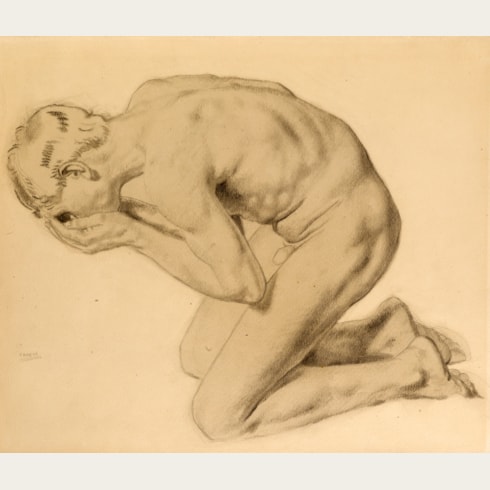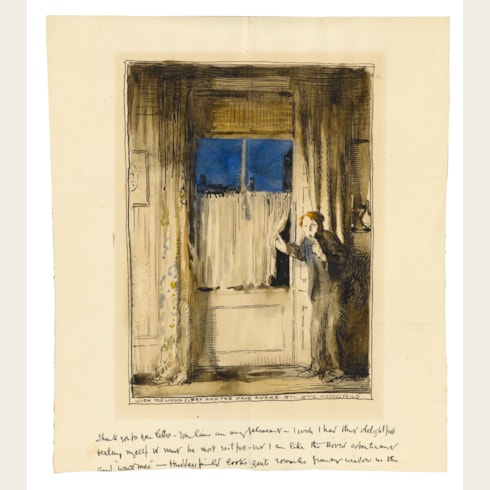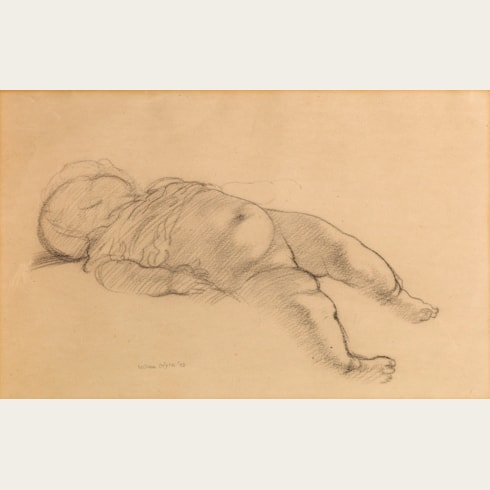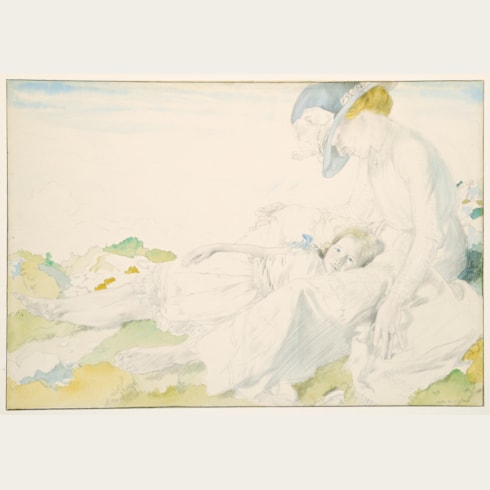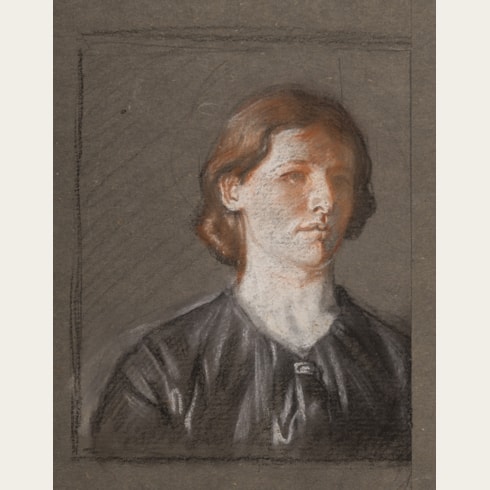William ORPEN
(Stillorgan 1878 - London 1931)
Study for The Holy Well: A Nude Couple and a Kneeling Man
Signed ORPEN in pencil at the lower left centre.
Signed, dated and dedicated To George Roller / with many thanks / William Orpen / December 1930 in pencil at the lower right.
647 x 425 mm. (25 1/2 x 16 3/4 in.)
Orpen seems to have intended The Holy Wellas an allegory of the Celtic customs, morals and religious practices of his native Ireland, and the composition may have been inspired in part by John Millington Synge’s play The Well of the Saints. A large painting, measuring over 8 1/2 by 7 feet, The Holy Well(which the artist, in his correspondence, also referred to by the title ‘Nude Pattern’) depicts the naked figures of the pagan Celtic people of ancient Ireland who, made to drink from a well, are thereby transformed into Christian Aran islanders. The background depicts Celtic crosses and native dwellings of the 6th and 7th centuries, and the scene is dominated by the figure of Orpen’s pupil and assistant Seán Keating, standing on a wall and surveying this ritual with an expression of benign cynicism. It was in fact Keating who seems to have inspired the painting, since he had spent the summer of 1915 painting in the Aran Islands, in Galway Bay, and had returned to London with paintings and drawings of the area, as well as a selection of local costumes, which Orpen used for his picture.
Orpen’s biographer P. G. Konody described The Holy Well as ‘a fascinating, whimsical, somewhat scattered design of men and women – some of them amusingly reminiscent of Rodin – in every stage of complete or partial déshabille, gathered around the miraculous spring.’ A recent scholar has noted that the painting ‘has been read as an ironic complaint against the Church, as if an allegory; but Orpen’s persistent use of humour is difficult to interpret. He had rarely used life studies in his paintings, and follows [Augustus] John both in this and in the drama of unrestrained nudity versus the decorum of dress. It was presumably the Irish revival as well as the war in Europe that led him to take up a grand style, and to plan so elaborately. His artist friend Sean Keating, depicted standing over the well, is defiantly modern and quizzical, and the figures below seem to represent an expulsion from their paradise.’
As he had for Sowing New Seed and The Western Wedding, Orpen devoted a considerable amount of time to making careful preparatory drawings for The Holy Well, both for individual figures and groups of figures. As Seán Keating recalled of The Holy Well, ‘The drawings from which he painted the figures were done in lead pencil on smooth white paper, the tones rubbed in with a paper stump. Orpen greatly admired Ingres’ drawings whom he rather resembled in looks but in my opinion they are finer than Ingres’, tho’ it is considered heresy to say so.’ A fine example of the artist’s draughtsmanship of this period, the present sheet must have been drawn fairly early in the process of developing the composition of the painting, since the kneeling figure at the lower left does not appear in the final work.
Exhibited at the New English Art Club in 1916, Orpen’s painting of The Holy Wellwas purchased for the sum of £2,000 by the artist’s wealthy American patron and mistress, Florence Evelyn St. George, who also acquired seventeen large preparatory studies for the picture. The painting was hung on the staircase of her London residence, Cam House in Kensington, and, together with its preparatory drawings, was lent by her to the retrospective exhibition of Orpen’s work held at the Royal Academy in 1933. After Mrs. St. George’s death, The Holy Well, together with the rest of her collection and the contents of Cam House, was sold at auction in London in July 1939, and was eventually acquired by the National Gallery of Ireland in 1971.
As P. G. Konody has noted of the paintings that make up the ‘Irish Trilogy’, ‘These decorative compositions, with all their unconventionality and whimsical waywardness of spirit, were deliberately planned works, the result of much thought and numerous preliminary studies.’ Orpen’s large pencil studies for various figures in The Holy Well, sometimes enlivened with added touches of watercolour, are characterized by a particular sensitivity and meticulous technique. The artist’s studio book lists a number of preparatory drawings for The Holy Wellwith names against them, suggesting that they may have been reserved for buyers other than Mrs. St. George, but it is unclear whether all were in fact dispersed, since some, like the present sheet, may well have remained in his studio for many years after the painting was completed. As the artist’s dedicatory inscription at the lower right attests, the present sheet was presented by Orpen to a friend in 1930, some nine months before his death. Other preparatory drawings by Orpen for The Holy Wellare today in the National Gallery of Ireland in Dublin, the Metropolitan Museum of Art in New York, and in several private collections.
William Orpen showed a talent for art at an early age, and in 1891 was admitted into the Metropolitan School of Art in Dublin. He soon came to the attention of his teachers and contemporaries as an immensely gifted draughtsman, and won several prizes for his drawings. In 1898, he transferred to the Slade School of Art in London, where his drawings continued to impress all who saw them. At the Slade, where his professors included Philip Wilson Steer and Henry Tonks, he met and befriended Augustus John. The two young artists soon came to dominate their class at the school, where they were quickly recognized as head and shoulders above their fellow students in terms of talent. Orpen joined the New English Art Club, and exhibited at the Royal Academy and the Royal Hibernian Academy. He was appointed an Official War Artist in 1917, and his powerful paintings and drawings of the trenches in France were exhibited in London the following year. Knighted in 1918, Orpen later published more of his scenes of the war in An Onlooker in France, 1917-1919, which appeared in 1921. The 1920’s found the artist at the height of his success, firmly established as one of the leading portrait painters in England, with a fashionable clientele and no shortage of commissions. Yet after his death at the age of only fifty-two his reputation lapsed into obscurity, and it has not been until relatively recently that he has regained something of the stature he once enjoyed.
Throughout his career, William Orpen was admired as one of the finest draughtsmen of his day. He drew for long hours every day, and left behind a large corpus of drawings and sketches. As the critic of The Art News commented of a publication of a portfolio of ten photogravure reproductions of his drawings in 1915, ‘These drawings are remarkable not only for their delicacy of handling, but for the loving care with which the pencil has revelled in beauty of form. Mr. William Orpen is thoroughly modern, yet he continues a tradition which has been handed down from the great draughtsmen of the past. His work does not suffer when placed by the side of the work of the Old Masters, a supreme but dangerous test.’
Another critic, writing at the same time in The Ladies’ Field, noted that ‘Mr. Orpen may be described as a tender draughtsman, tender in his care of and love for his materials. His hand is so marvellously delicate. His pencil hovers over the paper with the grace of a butterfly…He does not strive for the beauty of feature, as the French draughtsmen of the eighteenth century tried to capture those qualities. At times he is almost ugly and brutal; but he never loses the beauty of form.’
Provenance
Supposedly given by him to the jockey Joseph (‘Joe’) Childs, Portsmouth
Thence by descent.
Literature
Exhibition





